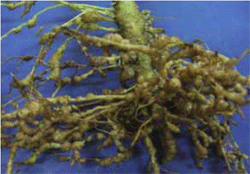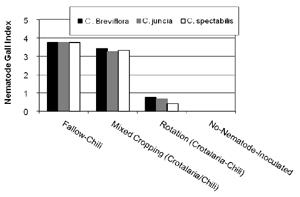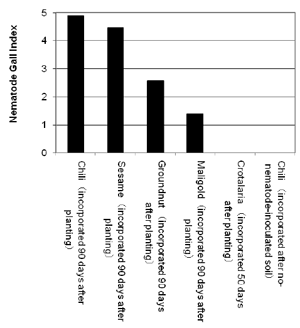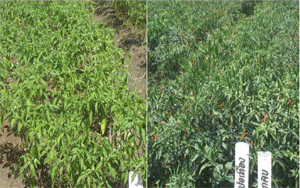Crotalaria is effective against nematode damage of chili in Southeast Asia
Description
Production of chili or hot chili (Capsicum spp.) is widespread for greengrocery and processing purposes in tropical countries such as Thailand, which has a cultivation area of approximately 23,840 hectares, as of 2007. In the northeast part of Thailand, however, farmers suffer from considerable yield reduction because of the damage caused by the nematodes, Meloidogyne incognita (Fig. 1) and they are forced to plant other crops in their fields or stop growing the chili. We aimed at evaluating the effectiveness of crotalaria in order to formulate practical measures to mitigate the damage caused by M. incognita in tropical areas. Crotalaria has been proven to be effective in controlling nematode in temperate areas, but there is not enough evidence to show its effectiveness in tropical areas.
Concrete pots were filled up with nematode-contaminated soil and tomato was cultivated for two months to increase the number of nematode Meloidogyne incognita. In the rotation treatment, three species of crotalaria (Crotalaria juncea, C. breviflora, and C. spectabilis) were sown and incorporated into the soil after the flowering stage (50-60 days after seeding), and then one-month-old seedlings of chili were transplanted. In the mixed cropping treatment, the one-month-old seedlings of three crotalaria and chili were transplanted. In the fallow-chili treatment, one-month seedlings of chili were also transplanted. Results showed that crotalaria was highly effective for controlling nematode infection on chili. Each of the three species was proven equally effective. But, the mixed cropping of crotalaria and chili was not able to control the infection of nematode (Fig. 2).
The C. juncea, sesame, peanut, marigold and chili were incorporated into nematode-contaminated soil in concrete pots followed by the cultivation of tomato for two months, and then one-month-old seedlings of chili were transplanted. Results showed that crotalaria was the most effective to control the infection by the nematodes (Fig. 3).
In the field experiment at Ubon Ratchathani, C. juncea was found to be remarkably effective in controlling the nematode infection, since the number of root knots was reduced (Fig. 4).
For use of this method, it is necessary to seed crotalaria in a relatively high density and grow it until the flowering stage to secure sufficient biomass. Although C. juncea is generally used as a green manure crop in Thailand, it is sometimes hard to obtain its seeds because of insect damage in the flowering period. In addition, both C. breviflora and C. spectabilis should only be utilized after their cultivation characteristics are fully confirmed.
Because crotalaria has high efficiency as green manure, it is expected not only to reduce chemical fertilizer use but will also lead to mitigation of nematode infection.
Figure, table
-
Fig. 1. Chili root system infected by the southern root knot nematode -
Fig. 2. Effect of crotalaria in suppressing the southern root knot nematode damage in chili plants.
Nematode gall index: no gall (0), a few galls per plant (1), galls in less than 1/4 of root system (2), galls in 1/4-1/2 of root system (3) galls in 1/2-3/4 of root system (4), and galls in more than 3/4 of root system (5) -
Fig. 3. Effects of various crops grown prior to chili in suppressing the southern root knot nematode damage (Gall indexes are the same as those in Fig. 2.). -
Fig. 4. Chili fields after fallowing (left) and growing and incorporating crotalaria plants (right).
- Affiliation
-
Japan International Research Center for Agricultural Sciences Research Planning and Coordination Division
- Term of research
-
FY2006~2008
- Responsible researcher
-
MIYATA Satoru ( Development Research Division )
TANGCHITSOMKID Nuchanart ( Department of Agriculture Thailand )
MANECKAO Sorasak ( Department of Agriculture Thailand )
- ほか
- Japanese PDF
-
2008_seikajouhou_A4_ja_Part11.pdf656.66 KB




